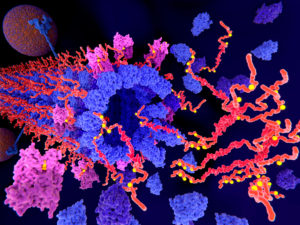Targeted drug delivery to the brain for treating neurodegenerative diseases

Tauopathies are a class of neurodegenerative diseases characterised by abnormal tau proteins, abundant neural proteins which are thought to play a role in a number of diseases by aggregating within cells, leading to cell death and cognitive decline. Alzheimer’s disease is the most prevalent tauopathy and the leading cause of dementia, which affects around 850,000 people across the UK.
Researchers at the University of Oxford have identified a novel method for selective drug delivery by targeting liposomes, a sphericle lipid vesicle containing the active agents, to molecules that are able to cross the blood-brain barrier, thus enabling the drug to accumulate at sites of interest within the brain.
Brain targeting of small molecules
Drug targeting to the brain is a major challenge due to the presence of the blood-brain barrier which exists between the central nervous system and peripheral circulation. The highly selective and tightly regulated, restricting the passage of molecules make it difficult for therapeutics to reach their active site within the brain.
Tau proteins are large-sized molecules that stabilize microtubules within cells and are abundant in the central nervous system. Microtubules provide structure to the cell, and so abnormal tau proteins cause toxic effects by aggregating and forming structures known as neurofibrillary tangles that cause microtuble breakdown, cell death and the subsequent cognitive decline seen in Alzheimer’s disease, frontotemporal dementia and other tauopathies.
Lipid-mediated transport
Researchers at the University of Oxford have developed a drug delivery vehicle for selectively delivering active agents to affected areas of the brain. It consists of a liposome, a sphericle lipid vesicle containing the active agents, conjugated to a targeting agent such as a Lewis antigen. The targeting agent specifically targets cell-adhesion molecules such as selectins, which are frequently transported across the blood-brain barrier and into microglial cells within the brain. Consequently, the targeting of these molecules enables the delivery of drug payload to sites of interest in areas of otherwise inaccessible brain pathology.
Commercialisation
Oxford University Innovation is seeking partners to license this innovative technology and support its continued development. A patent application has been filed to cover this method.
about this technology

